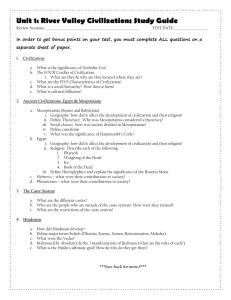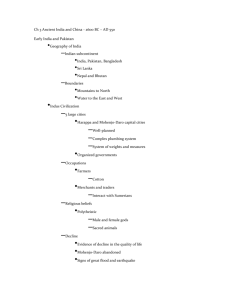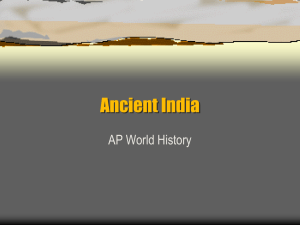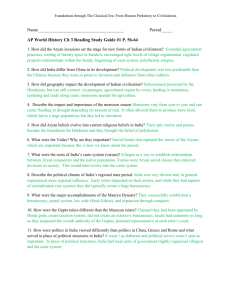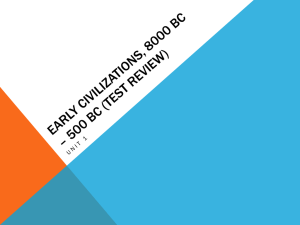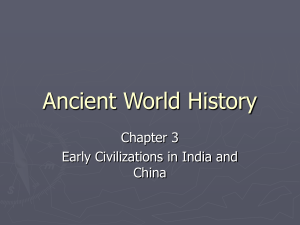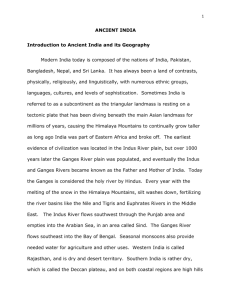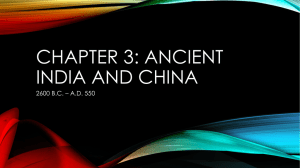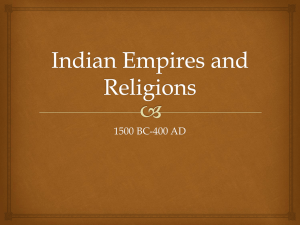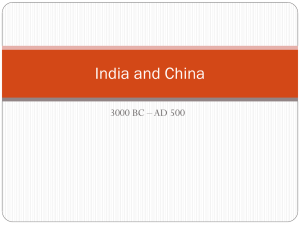Early Civilizations in India and China (2500 B.C.*256 B.C.)
advertisement
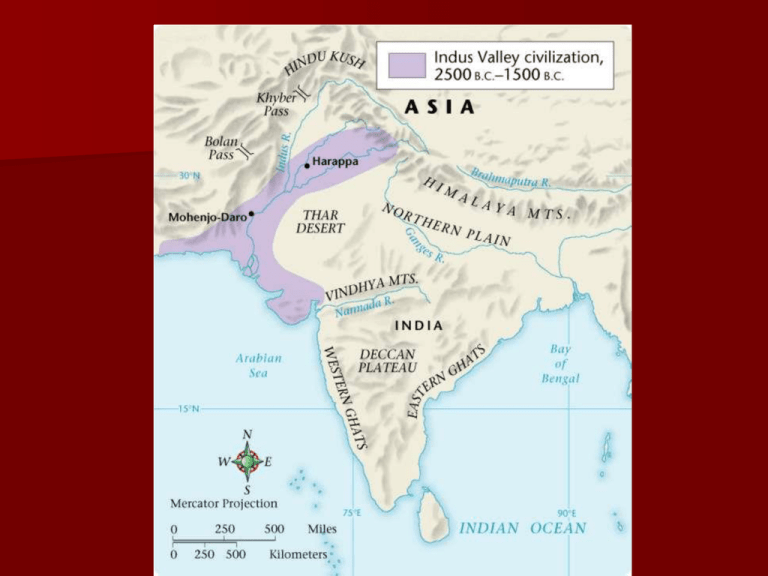
Chapter 3: Early Civilizations in India and China Part 1: India Geography of the Indian Subcontinent Mountains in the north limited contact- helped India to develop a distinct culture The subcontinent is divided into three major zones: – Northern plain- well watered, fertile region, 3 major rivers (Indus, Ganges, Brahmaputra), highly populated – Deccan Plateau- dry, unproductive, sparsely populated – Coastal Area- heavy seasonal rains, mountains, fishing •The rivers of India, particularly the Ganges, are considered sacred. •The monsoons, or seasonal winds, are a defining feature of Indian life. •Monsoons bring needed rain, but timing and amount matter. Indus Valley Civilization Indus Valley Civilization Early Indian civilization flourished for about 1,000 years, then vanished without a trace. Archaeologists have only recently begun to uncover evidence of these early people. Characteristics of the Indus Valley Civilization: Well-organized government Modern plumbing and sewer system Carefully planned cities-grid pattern Most people were farmers First people to cultivate cotton Covered largest area of any civilization at the time Started to trade with distant lands Polytheistic; honored mother goddess; worship of sacred animals influenced the later veneration of cattle Decline and Disappearance of Indus Valley Civilization No one knows for certain why the cities were abandoned and forgotten. Some theories include: -Too many trees were cut down. -A devastating earthquake destroyed the region. -A volcanic eruption caused the Indus to flood the city. -Aryan invaders overran the region. Kingdoms of the Ganges Aryan Invasion Most likely the Aryans destroyed and looted the civilization of the Indus Valley, they: Were nomadic warriors Built no cities and left no statues Felt superior to the people they conquered Were Polytheistic Religious teachings from the Vedas People born into castes, or social groups, which they could not change. Early Class System in Aryan Society Brahmins priests Kshatriyas warriors & royals Vaisyas farmers, merchants, craftsmen Sudras servants, laborers Aryan Civilization Expansion led to change in Aryan civilization because they: -mingled with the people they conquered -gave up their nomadic ways and settled into villages to farm and breed cattle -fought to control trade and territory -some rajas, or tribal chiefs, became hereditary rulers -developed the written language of Sanskrit Epic Literature Two great epic poems tell us about Aryan life and values: The Mahabharata celebrates battle and reflects important Indian beliefs about the immortality of the soul. The Ramayana celebrates a daring and adventurous hero and portrays the ideal woman as loyal and obedient to her husband. Hinduism Hinduism grew out of many varied beliefs of different peoples who settled in India. There was no single founder of Hinduism. Polytheistic- many gods and goddesses and many forms of worship. Development of the caste system came from Hinduism. The Basic Beliefs: Dharma- religious and moral duties all Hindus believe in, how you live day to day. Karma- all the actions of a person’s life that affect his or her fate in the next life. Moksha- free yourself from selfish desires to achieve union with brahman, the end of reincarnation Reincarnation- allows people to continue working toward moksha through several lifetimes. How they worship: Spiritual cleansing everyday (many in the Ganges) Worship at personal shrines Practice yoga and meditation Veneration of cattle Study sacred texts: Vedas and Upanishads Buddhism Siddhartha Gautama founded the religion of Buddhism. He was born around 566 B.C. to a highcaste family- left his family to find answers about life For 48 days he meditated and fasted until he understood the mystery of life He emerged as “Buddha”, the awakened one Teachings of Buddha Four Noble Truths (the heart of Buddhism) 1. 2. 3. 4. All life is full of suffering, pain, and sorrow The cause of suffering is the desire for things that are illusions (riches, power, long life) The only cure for suffering is to overcome desire The way to overcome desire is to follow the Eightfold Path ***SEE HANDOUT The Eightfold Path Eightfold Path, a middle road between a life devoted to pleasure and a life of harsh self-denial. ***See Handout More Teachings Live a moral life of- honesty, charity, kindness to all living creatures and to avoid evil words and actions. Enlightenment is achieved through meditation. The ultimate goal is nirvana, union with the universe and release from the cycle of rebirth. Spread of Buddhism Followers accompanied the Buddha as he preached across Northern India. Some Buddhists set up monasteries and convents that grew into centers of learning. Missionaries and traders spread Buddhism across India to many parts of Asia. Powerful Empires of India Maurya Emperors Chandrgupta was the first powerful Maurya ruler, conquering vast amounts of land. His grandson, Asoka fought a long, bloody war to conquer the Deccan plateau, 10,000 people were slaughtered. Asoka then converted to Buddhism, rejecting violence and living a moral life. Maurya Empire Maurya rulers: supervised the building of roads and harbors. collected taxes. created royal court systems. created a secret police force to report on corruption, crime, and dissent. Kingdoms of the Deccan People had many different languages and traditions. Left rich and diverse literature. Each kingdom had its own capital and magnificent temples. Rulers were tolerant of all religions and foreign settlers, improved harbors for trade with the Roman Empire and China. Women enjoyed high status and economic power. 2 The Golden Age of the Gupta’s India experienced a Golden age or a period of great cultural achievements during the rule of the Gupta. A golden age is marked by a time of peace and prosperity. A period of great achievement Medicine- doctors treated illnesses with herbs, performed surgery, set broken bones, vaccinated against smallpox Math- invented a system of numbers we use today, decimal system, concept of zero Architecture- designed stone temples and dome-shaped shrines called stupas. Carving & Painting- artists painted murals and carvings telling the story of the life of Buddha. The Caste System and Daily Life Caste rules governed every aspect of life and became more restricted–where people lived, what they ate, how they dressed, and what work they did. Life for the lowest ranking caste, the “Untouchables,” was harsh and restricted. Each caste had its own leaders and caste members cooperated to help one another. Family Life in India The ideal was the joint family, in which extended family all lived under one roof. The family was patriarchal. The father or oldest male had absolute authority. Family wishes came before individual wishes. Early on, children learned family duties, such as obedience of caste rules. Parents had a duty to arrange good marriages for their children, based on caste and family interests. The status and freedom of women decreased over time. A woman’s duties were to marry, obey her husband, and raise children. Village Life in India Economics- Villages were self-sufficient, producing most of the food and goods needed. Sometimes villagers traded at regional markets. Politics- Each village ran its own government with little interference as long as taxes were paid to the empire. A village council made decisions. Chapter 3: Early Civilizations in India and China Part 2: China The Geography of China China was the most isolated of the civilizations. Long distances and physical barriers (mountains, desert, jungle, ocean) separated China from Egypt, the Middle East, and India. Isolation contributed to the Chinese belief that China was the center of the earth and was the only civilization. Ethnocentrism- Belief in the superiority of one's own ethnic group. Chinese civilization began in a river valley, the Huang He. (Yellow River). The Dynastic Cycle in China Promoted idea of Mandate of Heavengods decide who would rule. Shang Dynasty (1650 B.C.–1027 B.C.) Controlled corner of northern China along Huang He River. Held complex religious beliefs. Beliefs of Yin and Yang. Developed written language used by all Chinese people. Zhou Dynasty (1027 B.C.–256 B.C.) Set up feudal state- lords governed their own lands, owed military service and other support to the ruler. Economy and commerce grew- use of money, ironworking, new crops. Population increased Cultural Achievements of Shang & Zhou: Made silk thread-a most valuable product. Made the first books from wood and bamboo. Studied the movement of planets and recorded eclipses of the sun. Developed accurate calendar with 365 1/4 days. Made remarkable achievements in the art of bronze making. Philosophy and Religion in China The Wisdom of Confucius Teachings of Confucius Confucius developed a philosophy that was concerned with how to ensure social order and good government. His ideas included: • Harmony results when people accept their place in society. • Everyone has duties and responsibilities. Filial piety, or respect for parents, is the most important duty. • A ruler has the responsibility to provide good government. Government leaders and officials should be well educated. Five Relationships Confucius stressed five key relationships: 1. 2. 3. 4. 5. Father over son Elder brother over younger brother Husband over wife Ruler over subject Friend to friend Legalism Legalism was another philosophy created to achieve order in society. The only way to achieve order is to pass strict laws and impose harsh punishments on lawbreakers. The ruler alone possesses power. Daoism Laozi founded Daoism in an effort to live in harmony with nature, not to bring order to society. Government is unnatural and is the cause of many problems. The best government is the one that governs the least. Buddhism in China Buddhism became popular among the Chinese. It was appealing because it: • promised an escape from suffering • offered hope of eternal happiness • presented Buddha as a compassionate, merciful god • taught that anyone could gain salvation through prayer, good works, and devotion The Qin Dynasty Emperor Shi Huangdi How did Shi Huangdi unite China? He: had military districts governed by loyal officials. spies reported on his officials. forced noble families to live in his capital so he could monitor them. jailed, tortured, and killed those who opposed his rule. had all books of philosophy and literature burned. standardized weights and measures. created uniformity in Chinese writing. strengthened the transportation system. ordered the building of the Great Wall & Terra Cotta Soldiers. Though his methods were brutal, Shi Huangdi ushered in China’s classical age during the Qin Dynasty. Called a classical age because it set patterns in government, philosophy, religion, science, and the arts that served as the framework for later cultures. Han Dynasty A new dynasty took over after the death of Emperor Qin. The Han Dynasty gained control after many years of war. Han rulers wanted to continue to unify China. Han rulers wanted to ease the harsh conditions that people lived under. Economic Improvements: Built more canals and roads Set up granaries across the empire Imposed a government monopoly on iron and salt Increase trade with western civilizations using the Silk Road Government Improvements: Made Confucianism the official belief of the state Relied on well-educated scholars to run the government Used a civil service exam to find the most qualified officials The Han Golden Age Science: Wrote texts on chemistry, zoology, and botany Invented seismograph to measure earthquakes Technology: Made paper out of wood pulp Pioneered advanced methods of shipbuilding Invented the rudder, fishing reels, wheelbarrows, and suspension bridges Medicine: Diagnosed diseases Developed anesthetics Explored uses of acupuncture Arts: Built grand temples and palaces Produced jade and ivory carvings and ceramic figures Improved bronze working and silk making techniques
